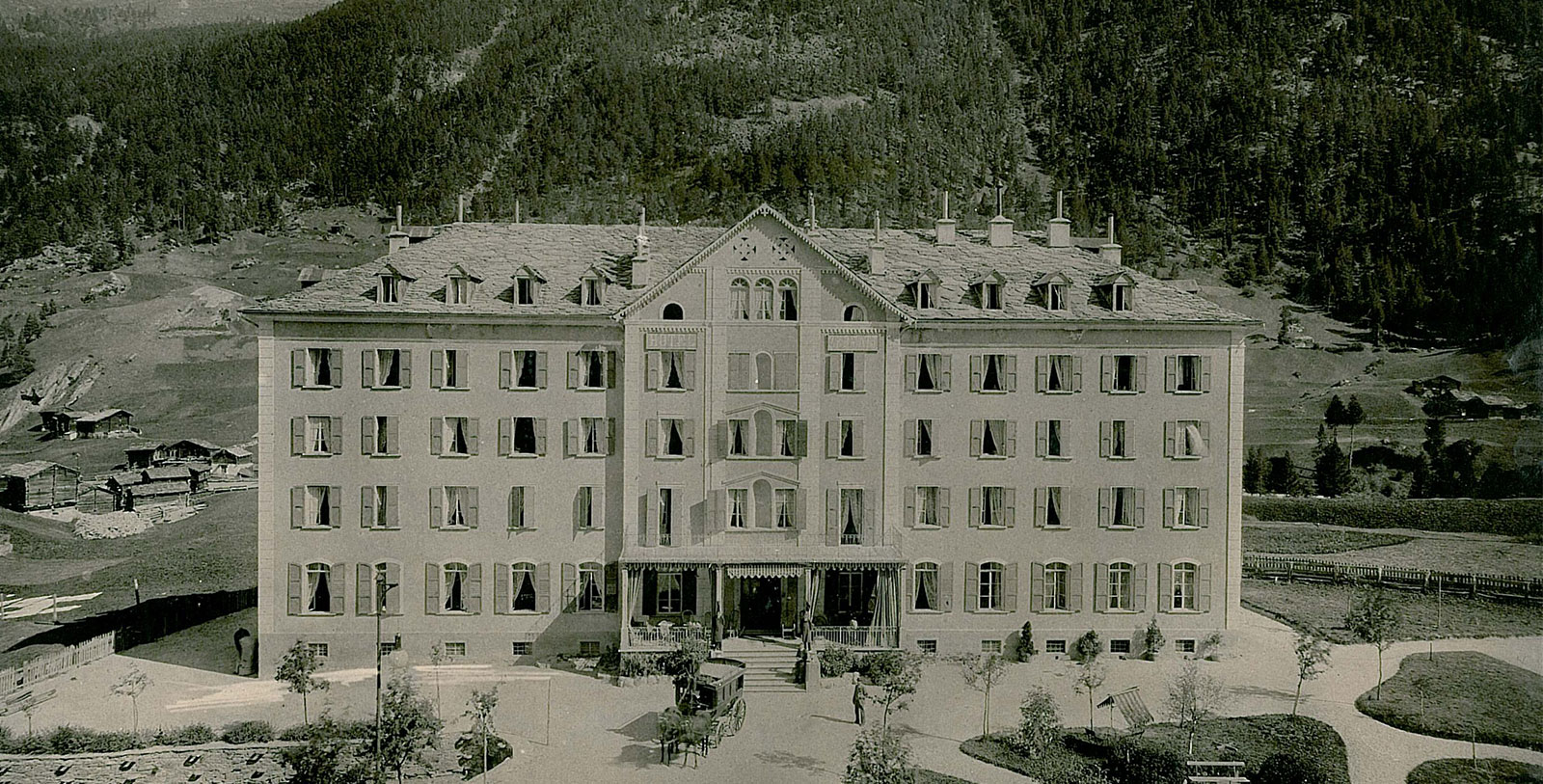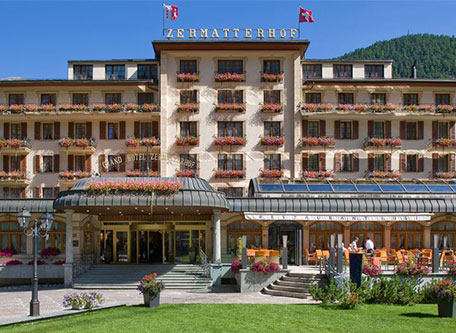Receive for Free - Discover & Explore eNewsletter monthly with advance notice of special offers, packages, and insider savings from 10% - 30% off Best Available Rates at selected hotels.
history
Discover the Grand Hotel Zermatterof, which has been operated by the same families since its debut over a century ago.
The Grand Hotel Zermatterof, a member of Historic Hotels Worldwide since 2021, has been in operation since 1879.
VIEW TIMELINEGrand Hotel Zermatterhof - A Hotel with History
Discover the history and heritage of the Grand Hotel Zermatterhof, a symbol of Zermatt, Switzerland since its opening in 1879.
WATCH NOWIn the mid-19th century, the Swiss town of Zermatt had undergone a significant transformation. The surrounding mountains of the famous Swiss Alps had become an important tourist attraction among European travelers from across the continent. Some were enthusiastic alpinists inspired by the local topography, while others were interested in escaping the rising tide of industrialization. The single greatest natural wonder that beckoned to them all was the massive Matterhorn, a towering pyramid peak that extends for nearly 14,700 feet into the sky. Soon enough, Zermatt’s sleepy pastoral streets were teeming with droves of foreign visitors in just a matter of years. Recognizing the economic opportunity the newcomers presented, a couple of Zermatt’s “burghers” pooled their resources to purchase a small hotel called the “Zermattsited Hotel Riffelberg” in the early 1860s. Constructed a decade earlier, it only numbered 18 guestrooms at the time—far too few for Zermatt’s now burgeoning travel industry. As a result, most of the prominent families quickly opened their own hotels, inns, and lodges, creating a brief network of rivalries throughout the town.
After watching the competition for several years, a pastor named Josef Ruden came up with a brilliant idea. Addressing his congregation, he proposed that all of the leading burghers and their respective houses contribute collectively to the construction of one massive Grand Dame that would serve as the crown jewel for Zermatt. Ruden petitioned the families frequently, gradually convincing them with his argument that it was for the greater civic good. Thankfully, the pastor’s counsel was embraced by every single burgher, and construction on the future Grand Hotel Zermatterof began in 1876. But not only had Ruden persuaded the burghers to construct the hotel—he even succeeded in having them contribute their labor for free as a means of keeping taxes low. In return, the burghers retained the right to operate the hotel indefinitely. As such, Zermatt’s leading families assumed control over the Grand Hotel Zermatterof when it finally debuted three years later. With its 94 guestrooms and 150 beds, the building was the single largest hotel at the foot of the Matterhorn. Its spectacular accommodations earned it a reputation for grand luxury, immediately becoming one of Switzerland’s most popular destinations.
Now a member of Historic Hotels Worldwide, the Grand Hotel Zermatterhof still rates among the country’s best hotels. It was even awarded “Switzerland´s Hotel of the Year 2021” by the Swiss Sunday newspaper Sonntagszeitung. Contemporary guests are picked up from the train station by either an electric car or a blue horse-drawn carriage. Once inside, visitors marvel at the hotel’s beautifully appointed guestrooms and the stunning views of the Matterhorn. Perhaps most impressive aspect of the Grand Hotel Zermatterhof is that the descendants of Zermatt’s burghers continue to manage the business. Thanks to their great dedication, the Grand Hotel Zermatterhof is well prepared to thrive for generations to come.
-
About the Location +
The town of Zermatt has a heritage that extends back generations. Historical sources from the 15th and 16th centuries refer to Zermatt by a number of different names, including “zer mat”, “zer Mat” or “zur Matt.” (“Zermatt” would become the official name for the community in the 1800s.) The name itself is actually a Germanic translation for the Italian phrase “Prato Borni” meaning “meadow among springs.” For centuries, Zermatt thrived as an isolated agricultural settlement within the heart of the Alps. Its population was originally governed by the Bishop of Sion, although the relationship between the two groups was often tense. Much of this animosity had actually spawned from the church’s decision to split the community into four distinctive neighborhoods, which diluted the ability of the locals to care for themselves. The area’s leading families subsequently led a prolonged campaign to achieve independence from the bishopric, struggling for years to obtain their freedom. Finally, in 1540, several prominent civil leaders—known locally as “burghers”—managed to acquire enough land to form their own municipality. The Bishop of Sion subsequently lost control over the land by 1618. In its wake, the local inhabitants had created three separate villages that nonetheless retained the same collective identity. Despite their relative autonomy, the communities closely coordinated with each other on many different political matters. In fact, the three towns operated a farming guild and even acknowledged a common set of local laws. Nevertheless, the settlements finally merged into one single entity in 1791, which would become the nucleus of contemporary Zermatt.
No sooner had the new town formed when the armies of Napoleon Bonaparte absorbed all of Switzerland into the French Empire. While the residents were essentially subjects of France, their exposure to the French Revolution led to the liberalization of the town’s government. A modern system of civil administration then gradually expanded throughout Zermatt, even after the Swiss regained their independence in 1814. The new government gave birth to such political bodies like the Zermatt Municipal Community and the Zermatt Citizens’ Community. The village of Zermatt grew in many other ways in the years following the Napoleonic Wars as well, specifically its transformation into a prominent resort community. The change happened in the 1860s, when British mountaineers arrived in the area during their explorations of the local countryside. They quickly spread word about Zermatt’s enchanting tranquility, causing many more travelers to visit the locale. Perhaps the single greatest moment that captured the imaginations of Europe’s tourists was Edward Whymper’s successful, yet tragic ascent up a towering local mountain called the “Matterhorn” in 1865. Many people subsequently flocked into downtown Zermatt upon hearing of Whymper’s tale, inspiring its permanent population to reorient the town’s economy toward tourism. Dozens of beautiful hotels and inns opened downtown, with the greatest being the Grand Hotel Zermatterof. Zermatt has since maintained its prestigious status as a renowned destination for outdoor adventurers, specifically those who enjoy hiking, skiing, and sightseeing. In fact, thousands of people arrive from around the world to bask in its proximity to verdant forests and gorgeous mountaintops.
-
About the Architecture +
The architecture that best defines the iconic exterior façade of the Grand Hotel Zermatterof can be described as “Belle Époque.” Originally popularized in Paris at the height of the Victorian Era, the architectural style drew its inspiration from a range of earlier forms that included Moorish Revival and Renaissance Revival-style architecture. More recent architectural styles also constituted aspects of Belle Époque architecture, such as the palatial designs of 17th and 18th century French châteaus. Perhaps the most famous style to emerge within the greater umbrella of Belle Époque architecture was that of Art Nouveau. Defined by its ornate interior designs, Art Nouveau was best represented by Hector Guimard’s wonderful Castel Béranger in 1898. The name “Belle Époque” specifically referred to time in European history marked by its technological advances, pristine artwork, and relative peace. While the Belle Époque is a historical period relevant to most Western countries, it specifically applies to France and the life of the French Third Republic (1870 – 1914). Belle Époque architecture was eventually phased out during the 1920s in favor of a new style known as “Art Deco.”
But this wonderful Grand Dame also showcases elements of what is now referred to as “Swiss chalet” architecture. Swiss chalets were once rustic cottages that first emerged as seasonal farmhouses around the height of the Middle Ages. Indeed, the Swiss chalet was a refuge for cattle herders, who would bring their livestock up the mountain ranges during the warmer months. The house itself functioned as a secondary home, within which the farmers would create a variety of dairy products for trade. But the chalets lost their original purpose as time passed, gradually turning into quaint holiday homes instead. The main reason behind the transformation was the emergence of the Swiss Alps as a popular tourist destination in the 19th century, specifically among the British and the French. They eventually discovered the many chalets scattered about the country and began buying them up in great numbers.
The foreigners subsequently renovated the chalets to reflect their romanticized views of alpine life in Switzerland. Soon enough, the new iteration of the chalet had swept across the region. Many natives went as far as to alter their own homes to resemble the aesthetic, essentially making the architecture “Swiss” in the process. Many largescale commercial buildings in Switzerland eventually featured the style, too, including restaurants, storefronts, and hotels. A few Swiss construction companies even created premade vacation chalets for people to build in other countries throughout Europe and North America. The chalets themselves were typically very beautiful, despite the rusticity of their layout. Set upon a rectangular foundation, the buildings were most easily recognized for their widely gabled roofs and facades of carved details and wooden balconies. Other iconic features included exposed construction beams, large windows, and weatherboarding.
-
Famous Historic Guests +
Walt Disney
Audrey Hepburn
-
Film, TV, and Media Connections +
Walt Disney, the famed storyteller and fairytale aficionado himself, stayed at the Grand Hotel Zermatterhof over the course of several summers. Enchanted by the Matterhorn, Walt began production on the film “The Third Man on the Mountain” in 1958. The movie was shot in Zermatt over the course of three months and was inspired by mountaineers like Edward Whymper and Lucy Walker. Though the film was not a rousing success, Walt was pleased with the final product and even opened an attraction in Disneyland inspired by the film and his own adventures in Zermatt. The Matterhorn Bobsled ride started running on June 14, 1959 and has remained one of the top attractions in the park ever since.



























